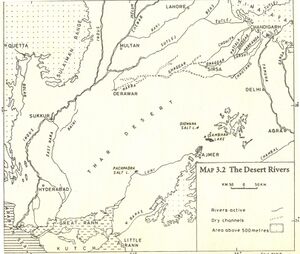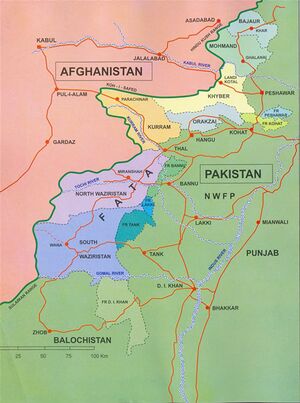Sulaiman Mountains


Sulaiman Mountains (Hindi:सुलैमान पर्वतमाला, Pashto: د كسي غرونه; Balochi/Urdu/Persian: کوه سليمان) are the southern extension of the Hindu Kush mountain system located west of Indus River.
Variants of name
- Suleman सूलेमान दे. Pariyatra पारिपात्र (AS, p.984)
- Kōh-e Sulaymān
- Koh-i Sulaiman
- Sulaimans
- Sulaiman range
- Suleman
- Suleman range
- Takht-e-Sulaiman
- Trikakut
- Anjan Parvat/Anjana Parvata/Anjanaparvata (अंजनपर्वत) (AS, p.4)
Location
It is located in the Zabul, Kandahar and Loya Paktia regions of Afghanistan, and in the southern Federally Administered Tribal Areas (South Waziristan and Frontier Region Dera Ismail Khan), most of northern Balochistan, and some of southwestern Punjab and Khyber Pakhtunkhwa in Pakistan.
The Sulaimans form the eastern edge of the Iranian Plateau where the Indus River separates it from the Subcontinent. Bordering the Sulaimans to the north are the arid highlands of Central Hindu Kush or Paropamisadae, whose heights extend up to 6,000 metres.
In Frontier Region Dera Ismail Khan, the highest peak of the Sulaimans is Takht-e-Sulaiman or "Throne of Solomon" at 3,487 metres. In Balochistan, its highest peak is Zarghun Ghar at 3,578 metres near Quetta city; while the second-highest is Khilafat Hill at 3,475 metres in Ziarat district.
Geography
The Sulaiman range runs north in Loya Paktia and meets the Spin Ghar range northeast of Gardez in Paktia province. To the northwest, the Sulamains merge beyond Loya Paktia into the Koh-i-Baba range. To the east, the Sulaimans enter the districts of Dera Ghazi Khan in Punjab and Dera Ismail Khan in Khyber Pakhtunkhwa, and approaches the Indus River near Mithankot in the Rajanpur District of Punjab. The eastern slopes drop very quickly to the Indus River, but towards west, the mountain range drops gradually in Kandahar southwest into Helmand and the Sistan Basin.
Rivers
Rivers that flow out from the Sulaimans include the Gomal River which flows eastward into the Indus River, and the Dori River and other small tributaries of the Arghandab River, which flows southwestward into the Helmand River.
History
In the Pashtun and Gandhara legend, one of the highest peaks of the Takht-i Sulaiman ("Throne of Solomon"), 3,382 metres high, is associated with Prophet Solomon. Ibn Battuta names it Koh-i Sulaiman. It is related that Prophet Solomon climbed this mountain and looked out over the land of South Asia, which was then covered with darkness, but he turned back without descending into this new frontier, and left only the mountain which is named after him (from Ibn Battuta). According to another legend, Noah's Ark alighted in the Takht-i Sulaiman after the Deluge.
One legend says that Qais Abdur Rashid, said to be the legendary ancestor of the Pashtun nation, is buried on top of Takht-e-Sulaiman, locally known as Da Kasī Ghar (د کسي غر, "Mount of Qais"), located near the village of Darazinda in Frontier Region Dera Ismail Khan of the Federally Administered Tribal Areas, close to the border with both South Waziristan and Zhob, Balochistan. The legend has it that from there, his different descendants migrated west, north, and south. Some people visit the place and make animal sacrifices, usually a sheep or a goat, at the tomb of Qais to help feed the poor. A trip to the mountain is undertaken mostly in summer, since from late November until March the snowfall makes it difficult to climb.
Al-Biruni, who himself lived a large part of his life in Ghazni located just northwest of the Sulaimans, writes of the mountains in his memoirs as being the western frontier mountains of Asia and the homeland of an Ajami ("non-Arab") or Persian tribe known as the Pashtuns.
सूलेमान पर्वत-श्रेणी
सूलेमान (AS, p.984): सिंधनदी के पश्चिम में स्थित पर्वत-श्रेणी ( दे. पारिपात्र
अंजनपर्वत
विजयेन्द्र कुमार माथुर[1] ने लेख किया है ...अंजनपर्वत (AS, p.4) - वराहपुराण 80 में उल्लिखित संभवत: पंजाब की सुलेमान-गिरिशृंखला है।
वायुपुराण के अनुसार यह एक पहाड़ी का नाम है, जो सितोद सर के पश्चिम में स्थित है।(वायु पुराण 36.28) यहाँ उरगों का निवास कहा गया है। (वायु पुराण 36.28) यह हाथियों के जगंल के नाम से विख्यात है। ( वायु पुराण 39.49.)[2]
पारियात्र
विजयेन्द्र कुमार माथुर[3] ने लेख किया है ...1. पारियात्र (AS, p.552): पश्चिमोत्तरी विंध्य शैलमालाओं का एक नाम जिनमें संभवत: अर्वली की श्रेणियां भी सम्मिलित थीं (देखें: पार्टीजर - जर्नल आफ द रॉयल एशियाटिक सोसायटी 1994, पृ. 258). रघुवंश 18,16 के अनुसार कुश के वंशज राजा अहिनगु के पुत्र पारियात्र और पारियात्र पर्वत को जीता था. पर्वत का नाम संभवत: इसी प्रतापी नरेश के नाम पर हुआ था, 'तस्मिन् प्रयाते परलोकयात्रां जेतर्यरीणां तनयं तदीयम्, उच्चै: शिरस्त्वाज्जित पारियात्रं लक्ष्मी: सिषेवे किल पारियात्रम्' अर्थात अहिनगु के परलोक सिधारने पर शत्रुजेता पारियात्र ने उच्च शिखर वाले पारियात्र को जीतकर राज्यश्री को प्राप्त किया. महाभारत शांति पर्व 129,4 में पारियात्र का उल्लेख है-- 'पारियात्रं गिरिं प्राप्य गौतमस्याश्रमो महान्'. यहां इस पर्वत पर गौतम ऋषि के आश्रम की स्थिति बताई गई है. विष्णु पुराण 2,3,3 मैं पारियात्र की गणना भारत के कुलपर्वतों में की गई है-- [p.553] महेंद्रो मलय: सह्य: शुक्तिमानऋक्षपर्वत:, विंध्यश्च पारियात्रश्च सप्तैते कुलपर्वता:' श्रीमद्भागवत 5,19,16 में पारियात्र का उल्लेख ऋक्षगिरि के पश्चात है-- 'विंध्य: शुक्तिमान्ऋक्षगिरि: पारियात्रो द्रोणश्चित्रकूटो गोवर्धनो रैवतक...' दशपुर मंदसौर से प्राप्त 532-553 ई. के कूपशिलालेख में राज्यमंत्री अभयदत्त को पारियात्र और (पश्चिम) समुद्र के बीच के प्रदेश के राज्य का मंत्री बनाया गया है. इस समय मंदसौर में यशोवर्मन का राज्य था. श्री चि. वी. वैद्य ने पारियात्र का अभियान वर्तमान सुलेमान पर्वत से किया है क्योंकि उनके मत में रामायण में पारियात्र को सिंधु के पार बताया गया है. संभवत: पारियात्र सुलेमान और विंध्य की पश्चिमोत्तर श्रेणी दोनों ही पर्वतमालाओं का नाम था. नदियों, पर्वतों तथा नगर आदि के द्विनाम भारतीय साहित्य में अनेक हैं. (देखें विंध्य)
2. पारियात्र (AS, p.553)= Parayatra (पारयात्र): पारियात्र पर्वत का प्रदेश (हर्षचरित, उच्छवास 6). युवान्च्वांग ने यहां वैश्य राजा का शासन बताया है.
External links
References
Back to Mountains

